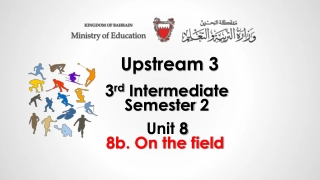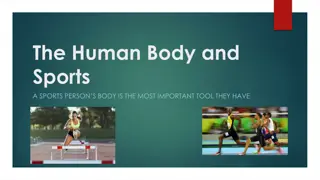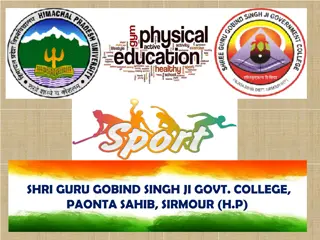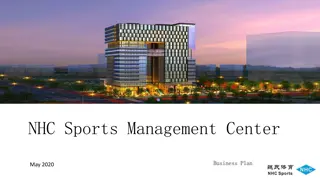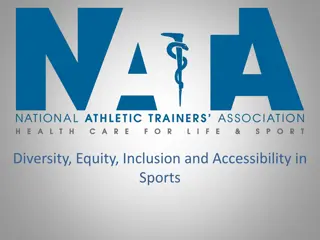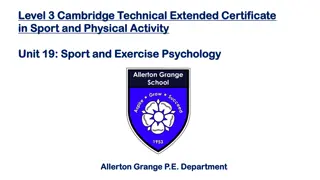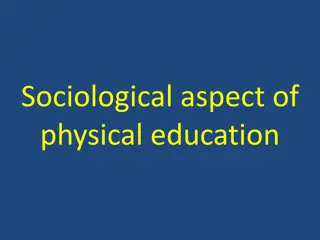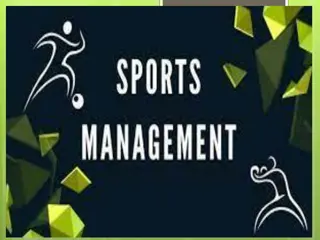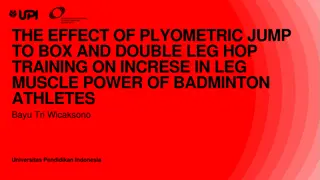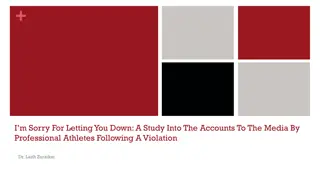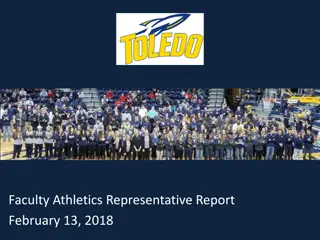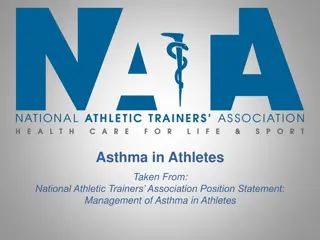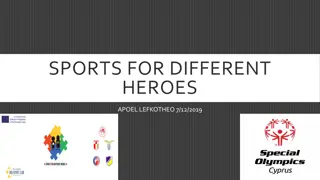Sports Medicine: Essential Information for Athletes and Enthusiasts
Sports medicine encompasses various professionals and therapies dedicated to treating and preventing injuries among athletes and physically active individuals. With a market on the rise, the field addresses the vulnerabilities of young athletes, common sports injuries, and the significant role of sports medicine practitioners. Learn more about the industry's growth and the importance of caring for sports-related injuries.
Download Presentation

Please find below an Image/Link to download the presentation.
The content on the website is provided AS IS for your information and personal use only. It may not be sold, licensed, or shared on other websites without obtaining consent from the author. Download presentation by click this link. If you encounter any issues during the download, it is possible that the publisher has removed the file from their server.
E N D
Presentation Transcript
The Medical Team for the Team and Individual Sports Enthusiasts Sports medicine includes an assortment of professionals and therapies focused on treating and preventing illness and injury among athletes and others who are physically active. Professionals are trained to help restore function to injured patients quickly. Most sports medicine doctors are certified in other disciplines, such as internal medicine, emergency medicine or orthopedics, and receive additional training in sports medicine. Physical therapists, certified athletic trainers and nutritionists are also in this field. The US sports medicine market was estimated at $1.884 billion for 2016 and accounted for 39% of the global market. The global market is forecasted to have a CAGR of 8.9% from 2017 to 2023, due to the popularity of sports and lack of a safety culture.
Young Athletes Vulnerable to Injury According to data from the US Department of Health & Human Services, there were approximately 8.6 million sports and recreation-related injuries on average per year in the US between 2001 and 2014. Of these, 64.9% affected youth, ages 5 24. More than 775,000 children, age 14 and younger, are treated in hospital emergency rooms for sports-related injuries every year. Most injuries are from falls, collisions, being hit with an object and overexertion. Most sports injuries (62%) occur during practice. Males were more likely to be injured, accounting for 61.3% of the injuries, and non-Hispanic Caucasian Americans were more likely to be injured than other groups. Half of the injuries were treated at a doctor s office or health clinic without an ER or hospital visit.
Types of Common Sports Injuries According to Grandview Research, knees are the individual body part most commonly injured during sports, accounting for 31% of injuries. Injuries of the head, neck and shoulder area account for 34% of the total. Sports injuries dislocations, hip fractures, ligament and tendon tears are a substantial portion of the orthopedic market, and are driving the increased use of medical devices, such as surgical equipment, bone reconstruction, tapes, compression and braces. The high incidence of sports injuries has generated more demand for minimally invasive surgeries, such as endoscopy and arthroscopy. Body reconstruction medical devices (relating to fractures and surgeries) are expected to be the biggest market segment.
Sports Medicine Practitioners According to IBISWorld, there were 96,182 sports medicine practitioner businesses and 119,206 sports medicine professionals in the US during December 2017. The American Medical Society for Sports Medicine (AMSSM) lists 2,250-member physicians, with specialties of family medicine, 71%; pediatrics, 8%; physical medicine/rehabilitation, 8%; internal medicine, 7%; and emergency medicine, 4%. Most AMSSM members are new to the profession: 42%, 1 5 years; 19%, 6 10 years; 23%, 11 20 years; and 17%, 21+ years. As of 2016, there were 27,600 athletic trainers, and the number of jobs is expected to increase 23% through 2026.
Sports Medicine Specialty Insights According to Medscape, physicians specializing in orthopedics were among the happiest physicians outside work, at 54%, while those specializing in physical medicine and rehabilitation had below-average levels of happiness outside work, at 50%. Physical medicine and rehabilitation doctors were among the most introverted, at 39%. Orthopedists were among the most extroverted (31%) as were surgeons (35%). Nine of ten (91%) Caucasian American and 88% of Asian American orthopedists are male. Orthopedists are the top-earning physicians, at an average of $489,000 per year, and their compensation increased 10% during 2017 from 2016. Almost all (95%) would choose the same specialty again. Still, only 48% feel they are being fairly compensated.
Advertising Strategies Contact sports medicine practitioners to sponsor any community/non-profit events, which your station also sponsor or promote, such as walks, runs, cycling and endurance. They can be on-call and/or distribute educational materials during the event. Advertise free or low-cost injury-prevention clinics to attract school-based teams, adult league participants and parents. Consider separate clinics/seminars for professionals, such as trainers and physical therapists who are able to refer new patients. When advertising your sports-training facility as a place where athletes can pay a fee to use the facility, include a secondary message that athletes, if injured during sports, can use the facility for post-treatment rehabilitation.
New Media Strategies Sponsor a youth athletic league and advertise on its Website with links to valuable information on your Website, social media pages and/or medical Websites. Follow sports clubs and leagues on Facebook and continually post injury-prevention and identification tips. Advertise low- or no-cost preseason physicals on Facebook parent groups.


